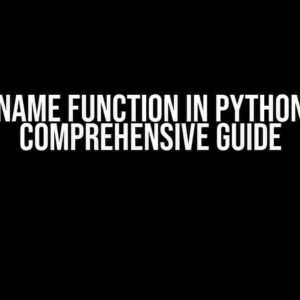Are you tired of traditional radiobutton behavior? Do you want to add a touch of innovation to your Tkinter applications? Look no further! In this comprehensive guide, we’ll explore the fascinating world of Tkinter radiobuttons and show you how to activate them on hovering – but only the first time. Yes, you read that right – the first time! We’ll dive into the nitty-gritty details, providing you with clear instructions, explanations, and code snippets to get you started.
Understanding Tkinter Radiobuttons
Radiobuttons are a fundamental component in Tkinter, allowing users to select one option from a group of mutually exclusive choices. By default, radiobuttons require a click to activate or deactivate them. But, what if we want to take it to the next level? What if we want to create a more engaging and interactive experience for our users?
The Power of Hovering
Hovering is an intuitive way to interact with GUI elements. It’s a subtle yet powerful gesture that can enhance the overall user experience. By activating a radiobutton on hovering, we can create a sense of anticipation and excitement, making our applications more engaging and dynamic.
The Challenge: Activating on Hovering *Only* the First Time
Now, here’s the twist: what if we want to activate the radiobutton on hovering, but only the first time the user hovers over it? This adds an extra layer of complexity, as we need to detect the first hover event and ignore subsequent hover events. Sounds daunting? Fear not, dear reader, for we have a solution!
Using the `bind` Method
The `bind` method is a powerful tool in Tkinter that allows us to associate events with widgets. We can use the `bind` method to detect the `
import tkinter as tk
root = tk.Tk()
radiobutton = tk.Radiobutton(root, text="Hover me!")
radiobutton.pack()
def on_hover(event):
# Activate the radiobutton on the first hover
radiobutton.invoke()
radiobutton.bind("<Enter>", on_hover)
root.mainloop()In this example, we create a radiobutton and bind the `on_hover` function to the `
The Problem: Subsequent Hover Events
However, this solution has a major flaw: subsequent hover events will continue to activate the radiobutton, which is not what we want. We need a way to detect the first hover event and ignore subsequent events.
The Solution: Using a Flag Variable
We can use a flag variable to track whether the radiobutton has been activated on hovering for the first time. If the flag is set to `True`, we ignore subsequent hover events.
import tkinter as tk
root = tk.Tk()
radiobutton = tk.Radiobutton(root, text="Hover me!")
radiobutton.pack()
first_hover = True
def on_hover(event):
global first_hover
if first_hover:
radiobutton.invoke()
first_hover = False
radiobutton.bind("<Enter>", on_hover)
root.mainloop()In this updated example, we introduce the `first_hover` flag variable, initialized to `True`. When the user hovers over the radiobutton for the first time, the `on_hover` function is called, activating the radiobutton and setting the `first_hover` flag to `False`. Subsequent hover events will not activate the radiobutton, as the `first_hover` flag is no longer `True`.
Advanced Techniques: Customizing the Hover Effect
Now that we have the basic functionality working, let’s take it to the next level! We can customize the hover effect by changing the radiobutton’s appearance, playing sounds, or even triggering animations.
Changing the Radiobutton’s Appearance
We can use the `config` method to change the radiobutton’s appearance when the user hovers over it. For example, we can change the background color, text color, or font.
import tkinter as tk
root = tk.Tk()
radiobutton = tk.Radiobutton(root, text="Hover me!")
radiobutton.pack()
first_hover = True
def on_hover(event):
global first_hover
if first_hover:
radiobutton.invoke()
radiobutton.config(bg="blue", fg="white")
first_hover = False
radiobutton.bind("<Enter>", on_hover)
def on_leave(event):
radiobutton.config(bg="SystemButtonFace", fg="black")
radiobutton.bind("<Leave>", on_leave)
root.mainloop()In this example, we change the radiobutton’s background color to blue and text color to white when the user hovers over it for the first time. We also use the `
Playing Sounds
We can use the `winsound` module (on Windows) or the `os` module (on Unix-based systems) to play a sound when the user hovers over the radiobutton.
import tkinter as tk
import winsound
root = tk.Tk()
radiobutton = tk.Radiobutton(root, text="Hover me!")
radiobutton.pack()
first_hover = True
def on_hover(event):
global first_hover
if first_hover:
radiobutton.invoke()
winsound.Beep(2500, 500) # Play a beep sound
first_hover = False
radiobutton.bind("<Enter>", on_hover)
root.mainloop()In this example, we play a beep sound when the user hovers over the radiobutton for the first time.
Conclusion
In this article, we’ve explored the unconventional technique of activating a Tkinter radiobutton on hovering, but only the first time. We’ve seen how to use the `bind` method, flag variables, and customizing the hover effect to create a more engaging and interactive user experience. By mastering this technique, you’ll be able to add a touch of innovation to your Tkinter applications and take your GUI design to the next level!
| Event | Description |
|---|---|
| <Enter> | Triggered when the mouse enters the widget’s boundaries |
| <Leave> | Triggered when the mouse leaves the widget’s boundaries |
This table summarizes the events used in this article. The `
Further Reading
Want to learn more about Tkinter and GUI design? Here are some recommended resources:
Happy coding, and remember to always keep your GUIs interactive and engaging!
Frequently Asked Question
Got some burning questions about Tkinter radiobuttons? We’ve got you covered!
How can I make a Tkinter radiobutton activate on hovering only the first time?
You can achieve this by binding the `
import tkinter as tk
root = tk.Tk()
var = tk.IntVar()
def on_enter(event):
if not entered_before:
rb.select()
global entered_before
entered_before = True
entered_before = False
rb = tk.Radiobutton(root, text="Radio Button", variable=var, value=1)
rb.bind("", on_enter)
rb.pack()
root.mainloop()
Can I use the same approach for multiple radiobuttons?
Yes, you can! Just create a separate flag for each radiobutton and update the `on_enter` function to check the corresponding flag. You can also use a dictionary to store the flags and radiobuttons for easier management.
How do I reset the flag when the user clicks on another radiobutton?
You can bind the `
Can I use this approach for other types of widgets, like buttons or checkboxes?
Yes, this approach can be applied to other types of widgets that support event bindings. Just adjust the event and the corresponding action accordingly.
What if I want to activate the radiobutton on hovering multiple times, but with a delay in between?
You can use the `after` method to implement a delay before allowing the radiobutton to be activated again on hovering. Just be sure to cancel the scheduled task when the user hovers out of the radiobutton.




